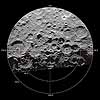| . |  |
. |
Florida Tech is collaborating with British Titanium, Cambridge University and the Kennedy Space Center on a NASA-funded project to produce oxygen from the Moon's regolith (top soil covering solid rock). The total budget for phase 1 of the project, titled, "ILMENOX," is $1.8 million with British Titanium serving as the primary contractor on the award. Initial phase 1 financial support to Florida Tech is $430,000. The goal of the study ultimately is to produce oxygen on the moon using the FFC Cambridge process, which uses electrochemical reduction of metal oxides in a molten salt electrolyte. Liquid oxygen is by far the largest component of rocket fuel, forming as much as 85 percent by weight. Its production on the moon would enable rockets to re-fuel on their way to far-flung corners of the earth's solar system. Project director is Dr. Derek Fray. He is a co-inventor of the FFC Cambridge titanium electrolytic production process, head of the Department of Materials Science and Metallurgy at the U.K.'s University of Cambridge and chief science officer for British Titanium. Florida Tech's Dr. Jonathan Whitlow, associate professor of chemical engineering, is Florida Tech's principal investigator on the project. Since 1998 he has conducted research with NASA support on In-Situ Resource Utilization (ISRU) from resources on the moon and in the Martian atmosphere. "Locally produced oxygen for rocket propulsion promises by far the greatest cost and mass savings. It is crucial to achieving a sustained and affordable human robotic program to explore the solar system and beyond," said Whitlow. The FFC process will possibly produce lower cost metals on earth, most notably titanium. According to Whitlow, "The use of this technology on the moon for ISRU is promising because it has the potential to extract virtually all of the oxygen from the lunar regolith at temperatures lower than competing processes, which have less extraction efficiencies." Manned space missions received presidential support in Jan. 2004 when George W. Bush announced plans to send an expedition to the moon by 2015. Related Links Florida Institute of Technology British Titanium SpaceDaily Search SpaceDaily Subscribe To SpaceDaily Express  Boulder CO (SPX) May 25, 2005
Boulder CO (SPX) May 25, 2005People of every culture have been fascinated by the dark "spots" on the Moon, which seem to compose the figure of a rabbit, frogs or the face of a clown.
|
| ||||||||||
| The content herein, unless otherwise known to be public domain, are Copyright 1995-2016 - Space Media Network. All websites are published in Australia and are solely subject to Australian law and governed by Fair Use principals for news reporting and research purposes. AFP, UPI and IANS news wire stories are copyright Agence France-Presse, United Press International and Indo-Asia News Service. ESA news reports are copyright European Space Agency. All NASA sourced material is public domain. Additional copyrights may apply in whole or part to other bona fide parties. Advertising does not imply endorsement, agreement or approval of any opinions, statements or information provided by Space Media Network on any Web page published or hosted by Space Media Network. Privacy Statement All images and articles appearing on Space Media Network have been edited or digitally altered in some way. Any requests to remove copyright material will be acted upon in a timely and appropriate manner. Any attempt to extort money from Space Media Network will be ignored and reported to Australian Law Enforcement Agencies as a potential case of financial fraud involving the use of a telephonic carriage device or postal service. |